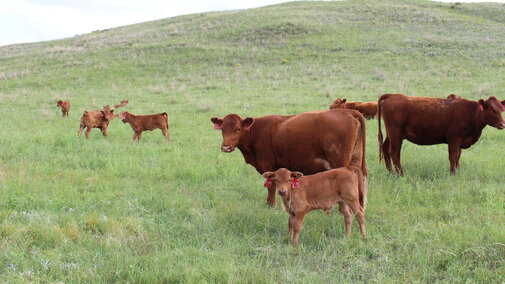Spring Turn-out to Pastures
The time for turn-out to our primary summer pastures is coming soon. A couple of important questions are what date to turn-out, and which pastures should be first?
For mixed cool- and warm-season native grass pastures, it is important to allow the cool-season grasses to reach at least a three-leaf stage. Initial grass growth in the spring comes from energy reserves stored in the roots and crowns of the grass plant. Grazing too soon could cause a depletion of those reserves and reduce production because there was not enough leaf area present to adequately begin producing energy from photosynthesis.
We must also remember that the amount of growth at a specific date can vary each year based on spring temperatures and precipitation. When the potential for drought is present, delaying turn-out and continuing to feed hay is recommended. This will allow the grass plants to maximize growth given the current soil moisture conditions and result in greater season-long production.
When grazing multiple native grass pastures in a rotation, it is beneficial to change the sequence or order of grazing for the set of pastures. This change in the time of grazing each year benefits the overall health and vigor of the grasses. For producers who have both native range and introduced grass pasture such as smooth bromegrass or crested wheatgrass, grazing the introduced grass pastures first is a great approach to use that resource and allows for a later turn-out on the native pastures.
Seedbeds for Planting Grasses and Alfalfa
Those looking to get grass or alfalfa seed into the ground this spring are doing so now. Before you fill up the drill and head out to plant, remember to prep the seedbed first.
When doing a planting of alfalfa or grass, seedbed preparation often plays a big role in germination success. Instead of just pulling into your field and planting, first get off your tractor and walk across the field. As you walk, look back at your footprints. Do you sink in more deeply than the soles of your shoes or boots? If so, your seedbed may be too soft.
Another technique is to bring to the field a seedbed testing kit. Now, most folks also call this kit a basketball, but a basketball tests seedbeds better than any other tool I know. Try to bounce the basketball in your field. It should be easy to bounce that basketball on a firm seedbed. If you can't bounce the ball easily, don't plant yet. Firm that seedbed even more with a flat harrow, a roller, or maybe even irrigate.
Why so much effort for a seedbed? Well, when small seeds germinate, their first roots must come into immediate contact with moisture and nutrients in the soil if those seedlings are to survive and grow rapidly. Loose seedbeds can have up to 50% dead airspace in the seeding zone. First roots that emerge into that dead airspace often do not live, and your stand will suffer. A firm seedbed reduces this dead airspace, which helps you get thicker stands that develop more rapidly.
Do you want better, faster developing grass and alfalfa stands with less risk of failure? A firm seedbed is your first step.
Grazing Reed Canarygrass
If you have wetlands, creek bottoms or just wet areas in pastures, you probably have some reed canarygrass. It is often the first perennial grass to green up in the spring.
Reed canarygrass is a high-producing cool-season grass that thrives in wetter conditions, in addition to well-drained soils. As the plant matures, palatability decreases rapidly so grazing it can be a challenge.
Reed canarygrass contains alkaloids, which are unpalatable chemical compounds. Reed canarygrass also has a very thick stem, which contributes to livestock preferring other plants to eat.
However, if cattle are turned out on it very early, it is good forage that they will eat. Reed canarygrass should be grazed before it is 10 inches tall and grazed down quickly to about three to four inches before moving to the next area to graze reed canarygrass. Once growth reaches almost 10 inches again, livestock can be put back on and will graze it. The nutritional quality of the forage is also high at this young growth stage.
This method does require some time and labor, but it is early forage and can be palatable if grazed in rapid rotation. Haying is also an option when it is still short, but spring dry-down can be challenging.
Reed canarygrass can be a good grass to graze, but it will likely take some practice and time to get it right.

